Dicentra canadensis, squirrel corn, is a small native perennial herbaceous plant that lives in the woods. Its distinctive snowy white flowers emerge in early spring and is a true spring ephemeral.
Flowers
Inflorescence/Flower cluster:
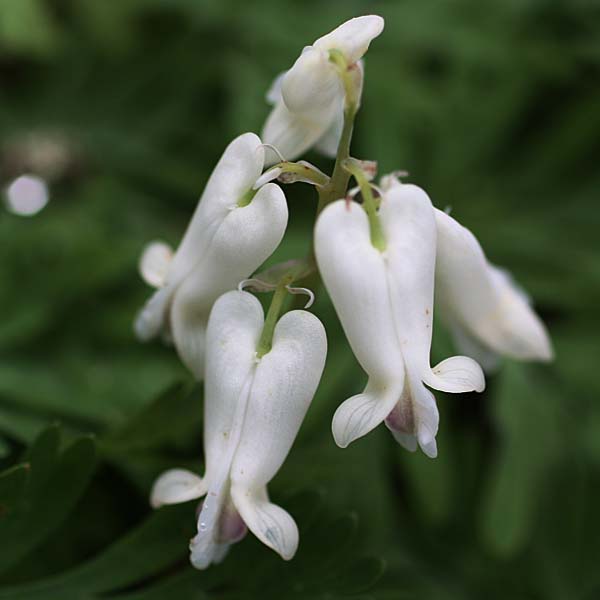 The Dicentra canadensis, squirrel corn, in the spring, produces a stem of 3-10 hanging flowers. Each flower is attached to the stem with a stalk (pedicel) so the arrangement is termed a raceme. There are no leaves on the flower stem. The stem can be 12 inches long erect or arching over the leaves below.
The Dicentra canadensis, squirrel corn, in the spring, produces a stem of 3-10 hanging flowers. Each flower is attached to the stem with a stalk (pedicel) so the arrangement is termed a raceme. There are no leaves on the flower stem. The stem can be 12 inches long erect or arching over the leaves below.
Individual Flower:
The Dicentra canadensis flowers are about 3/4 inches long. The shape of the corolla has been described as heart shaped or upside down pants. The flower has 2 outer petals and 2 inner petals. The outer petals are snow white and when the flower is mature, the bottoms of the outer petals are turned up and reflexive. At the bottom of the flower, parts of the inner petals are exposed - lateral wings and a dark bulge which forms a expanded tip. The inner petals surround the stigma and anthers. The flower has 6 stamens and 1 pistil. Sometimes the flower has a slight tinge of yellow at the waist.
In the labeled photo below of a flower, are:
- the pedicel, short greenish flower stalk
- two small bracts
- one of the 2 sepals (here pinkish)
- 2 outer petals, one on each side.
- parts of the 2 inner petals
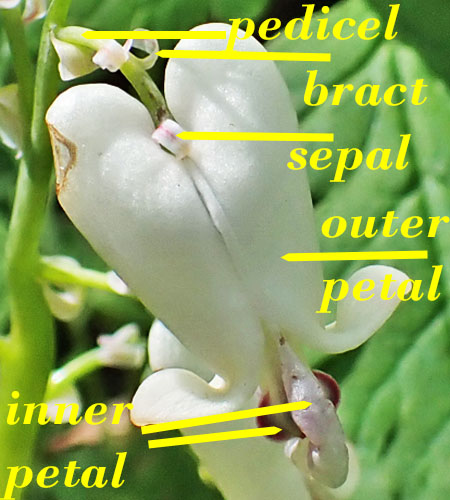
The two spurs (ends of the inverted pants legs) contain nectar to entice and reward pollinating insects.


In the photo to the left, the two upper flowers are shown in side view and are less mature. The bottoms of the outer petals have not yet turned up to expose the bulge at the bottom of the inner petals. However, the ruffled wings of the inner petals can be seen clearly.
The lower 2 flowers are more mature with the bottoms of the outer petals upturned and the exposed inner petals are seen in more detail.
In the photo below is an older flower that has been opened to see the stigma and some anthers inside the dark bulge.
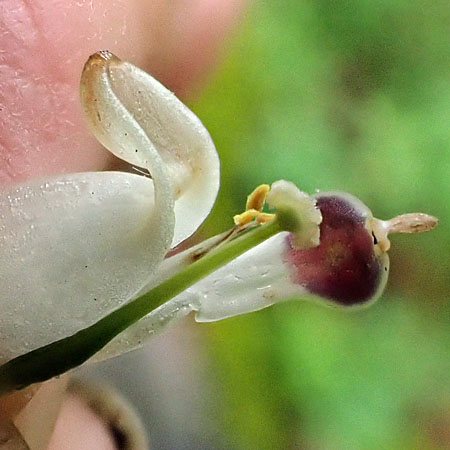
Pollination & fruit formation:
Squirrel corn & dutchman's breeches are frequently compared since they are closely related and have many similarities. The squirrel corn flower is fragrant while dutchman's breeches is not.
Like dutchman's breeches, pollinators for squirrel corn need to be around when it is still cool in April, have a long proboscis to reach the nectar that is stored in the tip of the spurs, and be strong enough to widen the opening at the bottom of the flower for access.
Meeting the requirements are queen bees. They are active in early spring looking for pollen and nectar to build a new nest, lay eggs and begin new colonies. The queen bees were fertilized the previous year. Only the queen survives the winter; all the other bees of her nest die off in the previous autumn.
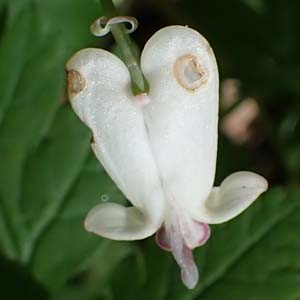
The fruit capsules can be a little longer than half an inch. In the photo, the remaining style and stigma can be seen.
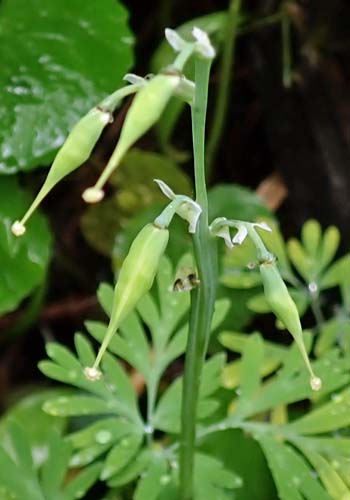
The seeds are small (2 mm) and numerous. Like some other spring ephemerals e.g. spring beauty and bloodroot, each seed has a small fleshy attachment, known as an elaiosome, that is rich in fats. The elaiosomes attract ants to carry off the seeds to their nest. The elaiosomes are eaten and the seeds are buried. This facilitates dispersal and the relationship is known as myrmecochory.
Leaves
Squirrel corn leaves are basal. There are 1 or 2 for each flower stem. The leaves are compound consisting of 3 main leaflets. The photos show all three main leaflets. These leaflets are further divided as can be seen. The leaves are deeply and finely cut producing a mass of leaflets.
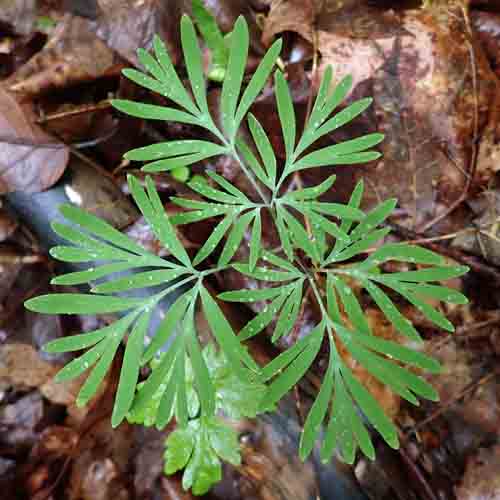

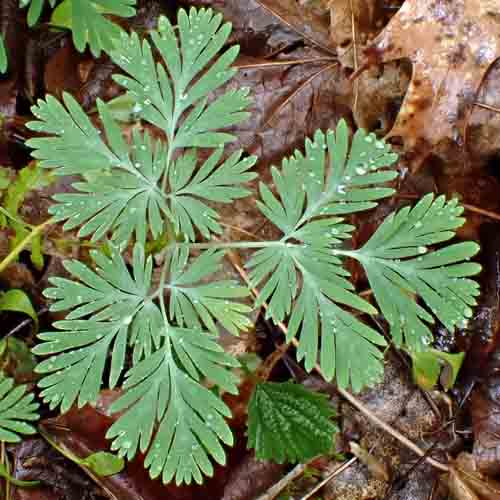
Plant - Habitat
The plant can be a foot tall with the flower stems. The flower stems can be erect or arching. They can be found on forest floors where the soil is rich and moist. They can form large mats to become a beautiful spring hardwood forest understory.
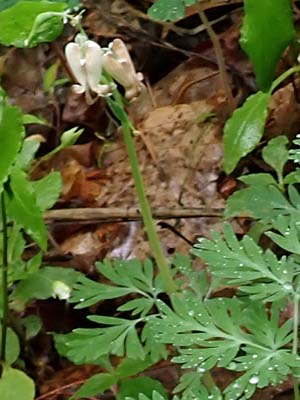

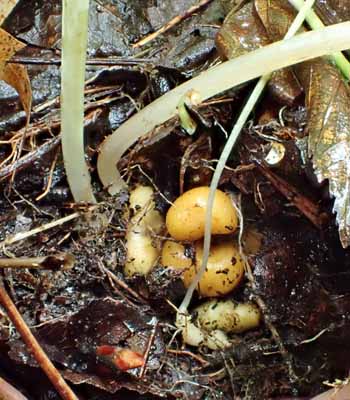 The plant develops from yellow bulblets just below the soil surface. Without harming the plant, the loose soil and leaf litter can be cleared away to see the bulblets. These bulblets serve as food storage and also provide for asexual reproduction.
The plant develops from yellow bulblets just below the soil surface. Without harming the plant, the loose soil and leaf litter can be cleared away to see the bulblets. These bulblets serve as food storage and also provide for asexual reproduction.
As a spring ephemeral, the squirrel corn leaves will wither before summer. After fruit set, the bulblets will go dormant until fall. In the fall, the stored starch will be converted to sugar and flower buds and leaf buds will be produced underground. These early stage flowers and leaves then remain dormant until spring. When the ground warms up in spring, the plant becomes active again and it already has a head start.
Like dutchman's breech, squirrel corn is toxic.
Squirrel corn, Dicentra canadensis, is frequently confused with dutchman's breeches, Dicentra cucullaria. The leaves are similar, but the flowers and bulblets are distinctly different. The squirrel corn bulblets are yellow and those of dutchman's breeches are white/pink. Squirrel Corn blooms about a week later. The spurs on the squirrel corn flower are more rounded and parallel. Attempts have been made to show the differences in the leaves, but that is difficult because of variations both species. In NJ, squirrel corn is S1 (Critically Imperiled) in rarity and dutchman's breeches is S4 (Apparently Secure). See the dutchman's breeches page: Click here.
Text by Millie Ling and all photos by Hubert & Millie Ling. Photos: Since squirrel corn is S1 in NJ, its locations are a well kept secret and we have not seen it in NJ. However, squirrel corn is not rare everywhere. These photos were taken in the Smoky Mts. Nat Park (TN & NC) 2011 and on our 2023 Joint Botanical Soc of A/ Philadelphia Botany Club 2023 Field Meeting in NC. All photos taken in April.
Additional information
Additional information / references:
- NJ DEP - Dicentra canadensis Rare Plant Profile: https://www.state.nj.us/dep/njnlt/profiles/dicentra-canadensis-squirrel-corn.pdf
- www.MissouriPlants.com: Dicentra canadensis page - good photos https://www.missouriplants.com/Dicentra_canadensis_page.html
- Illinoiswildflowers https://www.illinoiswildflowers.info/woodland/plants/squirrel_corn.html
- www.eFloras.org: Flora of North America http://www.efloras.org/florataxon.aspx?flora_id=1&taxon_id=233500571
- The Explorer at NatureServe shows Dicentra canadensis NJ S1(Critically imperiled) & G5(Secure). https://explorer.natureserve.org/Taxon/ELEMENT_GLOBAL.2.134192/Dicentra_canadensis.